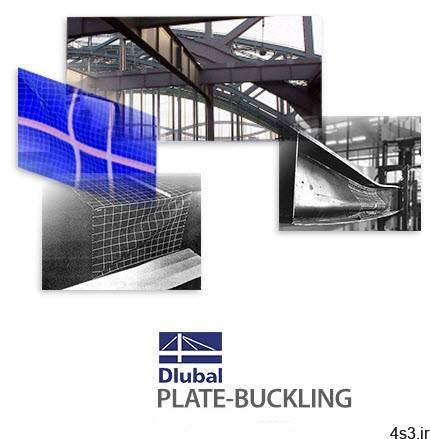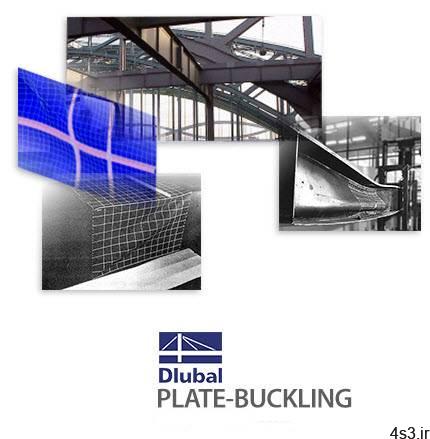

دانلود Dlubal PLATE-BUCKLING v8.24.01 x64 – نرم افزار تخصصی آنالیز و تحلیل کمانش ورق

PLATE-BUCKLING محصول قدرتمند شرکت Dlubal نرم افزار ی تخصصی در زمینه آنالیز و تحلیل کمانش ورقها و امکانسنجی افزودن ورقهای تقویت کننده میباشد. این نرم افزار به طور تخصصی برای انجام آنالیز کمانش ورق طبق دو استاندارد EN 1993‑1‑5:2006 و DIN 18800‑3:1990‑11 طراحی شده است. این نرم افزار همچنین در امکانسنجی اضافه کردن ورقهای تقویت کننده عمودی و افقی مانند ورقهای صاف، زاویهدار، T شکل، ذوزنقهای و کانالی نیز کاربرد وسیع دارد. در این نرم افزار ، ورقها به صورت المانهای محدود سه بعدی مورد تحلیل قرار میگیرند که این المانها را میتوان از نرم افزارهای RFEM و RSTAB وارد نرم افزار نمود. از قابلیتهای کلی نرم افزار میتوان به تحلیل تمامی تنشهای موجود در ورق، جداسازی جنس ورق اصلی و تقویت، انتخاب تقویت کننده از کتاب خانهی نرم افزار، تعیین ضخامت ورق با توجه به استاندارد، تعیین پارامترهای طراحی نظیر تنش، تغییر شکل و کمانش پیچشی برای تقویت کنندههای طولی و عرضی و بررسی تأثیر تقویت کنندهها اشاره نمود. قابلیتهای کلیدی نرم افزار Dlubal PLATE-BUCKLING: – تحلیل و آنالیز پیشرفته کمانش ورقها – تحلیل و امکانسنجی افزودن ورقهای تقویت کننده – دارای کتابخانهای وسیع از تقویت کنندهها – محاسبه کمانش بحرانی ورقها – بررسی تأثیر تقویت کنندههای مختلف بر روی ورق – قابلیت Render سه بعدی ورقها به همراه تقویت کنندهها – دارای امکانات مستند سازی پیشرفته دادههای مهندسی – امکان وارد کردن اطلاعات از RFEM و RSTAB – سازگاری با سایر نرم افزارهای شرکت Dlubal
ارسال لینک این صفحه از طریق ایمیل
اشتراک گذاری لینک این صفحه در WhatsApp
اشتراک گذاری لینک این صفحه در تلگرام
Tweet نمودن این مطلب!
اشتراک گذاری این مطلب در Facebook
اضافه نمودن این مطلب به بوک مارک گوگل
کپی نشانی کوتاه این صفحه در حافظه
Dlubal PLATE-BUCKLING is a separate stand‑alone program which performs plate buckling analysis of rectangular plates according to the EN 1993‑1‑5:2006 and DIN 18800‑3:1990‑11 standards. It is possible to apply horizontal or vertical stiffeners to the plates (for example flat plates, angles, T‑stiffeners, trapezoidal stiffeners, channel sections). Loading on the plate boundaries can be applied in several ways and can be imported from the main program RFEM/RSTAB. The plate buckling design in RF‑/PLATE‑BUCKLING is always performed on the total buckling panel as the potential stiffeners are considered in the 3D FE model. Thus, designs of single (c/t) parts or buckling panel sections are omitted.
Features: For design according to Eurocode 3, the following National Annexes (NA) are available: – Belgium NBN EN 1993-1-5/NA:2011-03 (Belgium) – Cyprus CYS EN 1993-1-5/NA:2009-03 (Cyprus) – CSN EN 1993-1-5/NA:2008-07 (Czech Republic) – SFS EN 1993-1-5/NA:2006 (Finland) – DIN EN 1993-1-5/NA:2010-12 (Germany) – UNI EN 1993-1-5/NA:2011-02 (Italy) – NEN EN 1993-1-5/NA:2011-04 (Netherlands) – NS EN 1993-1-5/NA:2009-06 (Norway) In addition to the National Annexes listed above, you can also define a specific NA, applying user-defined limit values and parameters. – Import of all relevant internal forces from RFEM/RSTAB by selecting numbers of members and buckling panels with determination of governing boundary stresses – Summary of stresses in load cases with determination of governing load – Separate materials for stiffener and plate – Import of stiffeners from an extensive library (flat plate and bulb flat steel, angle, T-section, channel, and trapezoidal sheeting) – Determination of effective widths according to EN 1993-1-5 (Table 4.1 or 4.2) or DIN 18800, Part 3, Eq. (4) – Optional calculation of critical local buckling stresses by analytical formulas of annexes A.1, A.2, A.3 of EC 3 or by means of FEA calculation – Designs (stress, deformation, torsional buckling) of longitudinal and transverse stiffeners – Optional consideration of buckling effects according to DIN 18800, Part 3, Eq. (13) – Photo-realistic representation (3D rendering) of buckling panel including stiffeners, stress conditions, and buckling modes with animation – Documentation of all input data and results in a verifiable printout report Input Initially, it is necessary to define material data, panel dimensions, and boundary conditions (hinged, built-in, unsupported, hinged-elastic). It is possible to transfer the data from RFEM/RSTAB. Then, boundary stresses can be either defined for each load case manually or imported from RFEM/RSTAB. Stiffeners are modeled as spatially effective surface elements that are eccentrically connected to the plate. Therefore, it is not necessary to consider the stiffener eccentricities by effective widths. The bending, shear, strain, and St. Venant stiffness of stiffeners as well as the Bredt stiffness of closed stiffeners is determined automatically in a 3D model. Design Designs are performed in iterative steps by eigenvalue calculation of the ideal buckling values for the individual stress conditions as well as of the buckling value for the simultaneous effects of all stress components. The buckling analysis is based on the method of reduced stresses, comparing the acting stresses with a limit stress condition reduced from the yield condition of von Mises for each buckling panel. The design is based on a single global slenderness ratio determined by the entire stress field. Therefore, the analysis of single loading and subsequent merging using interaction criterion is omitted. In order to determine the plate buckling behavior, which is similar to the behavior of a buckling member, the module calculates eigenvalues of the ideal panel buckling values using freely assumed longitudinal edges. Then, slenderness ratios and reduction factors are determined according to EN 1993-1-5, Chapter 4 or Annex B, or DIN 18800, Part 3, Table 1. Finally, the analysis is performed in accordance with EN 1993-1-5, Chapter 10, or DIN 18800, Part 3, Eq. (9), (10) or (14). The buckling panel is discretized in finite quadrilateral or, if necessary, triangular elements. Each element node has six degrees of freedom. The bending component of a triangular element is based on the LYNN-DHILLON element (2nd Conf. Matrix Meth. JAPAN – USA, Tokyo) according to the bending theory of Mindlin. However, the membrane component is based on the BERGAN-FELIPPA element. The quadrilateral elements consist of four triangular elements while the inner node is eliminated. Results Results are displayed with references to EN 1993-1-5 or DIN 18800. In addition, RF-/PLATE-BUCKLING shows calculation results separately for the action of only one edge load as well as for the simultaneous effect of all edge loads. In the case of several load cases, the governing load case is displayed separately. Thus, a time-consuming comparison of calculation data is not necessary. You can visualize the buckling modes and loads of buckling panel in the graphic window in order to facilitate a quick overview. Using the animation option, you can clearly represent the buckling behavior of stiffened plates. Finally, it is possible to export all tables to MS Excel or OpenOffice.org Calc or in a CSV file.
More info (open/close)
شرکت سازنده:
گروه نرم افزاری دلوبال / Dlubal Software GmbH
نام انگلیسی:
PLATE-BUCKLING
شماره نسخه:
v8.24.01 x64
نام فارسی:
پلیت-باکلینگ
قیمت:
600 یورو (صرفاً جهت اطلاع)
حجم فایل:
604 مگابایت
تاریخ انتشار:
10:52 – 1399/10/16 | 2021.01.05
منبع: پی سی دانلود / www.p30download.ir
امتیاز: 4.5/5
سیستم مورد نیاز
Operating systems:- Windows 7 SP1 (x64)- Windows 8.1 (x64)- Windows 10 (x64)Memory (RAM): 2 GBProcessor unit: 2 GHzGraphics: 256 MB dedicated
1- نرم افزار را نصب کنید.2- از درون پوشه Crack فایل های RSTAB64.sign و DL_Base64.dll را در مسیر پیش فرض “C:Program FilesDlubalPLATE-BUCKLING 8.24” کپی و با فایل های موجود جایگزین کنید.3- از درون پوشه Crack فایل AUTHORE.INI را در مسیر “C:ProgramDataDlubalGlobalGeneral Data” کپی کنید.4- نرم افزار را اجرا کنید.نکات:- نرم افزار فقط بر روی سیستم های 64 بیتی نصب می شود.- این نرم افزار توسط پی سی دانلود تست شده است.- نرم افزار را آپدیت نکنید و برای دریافت نسخه جدید به همین مطلب مراجعه کنید.- تمامی فایلها تا حد امکان فشرده شده و قابلیت تعمیر توسط نرم افزار WinRAR را در صورت ناقص دانلود شدن، دارا میباشند.
منبع : پی سی دانلود
رمز فایل : www.p30download.com
604 مگابایت دانلود با حجم :

4 مگابایت دانلود با حجم :
















































































